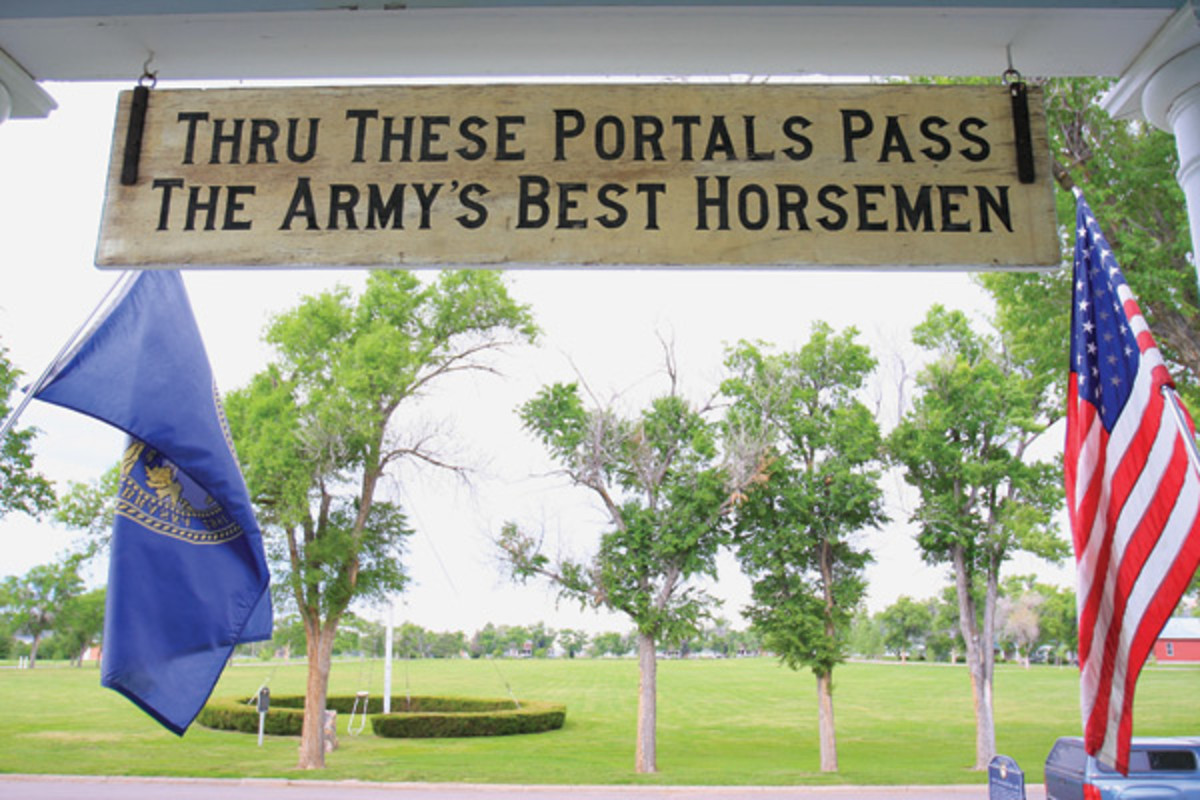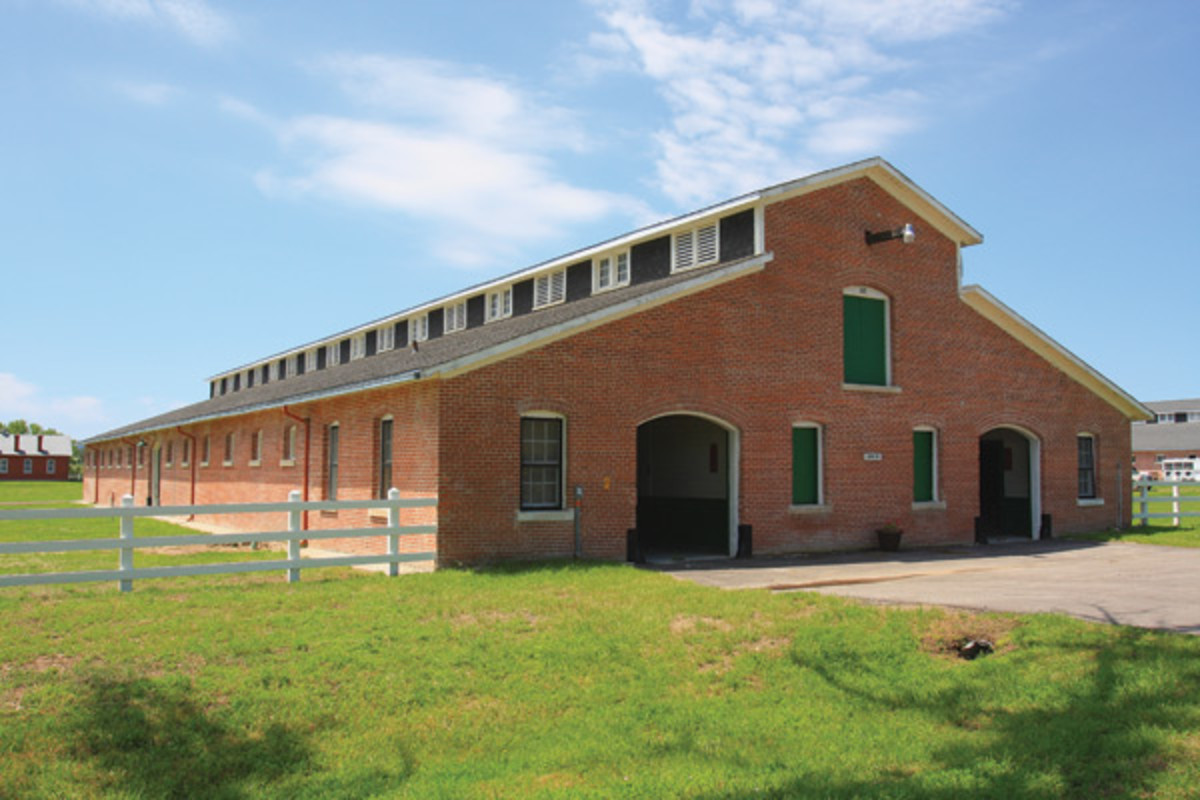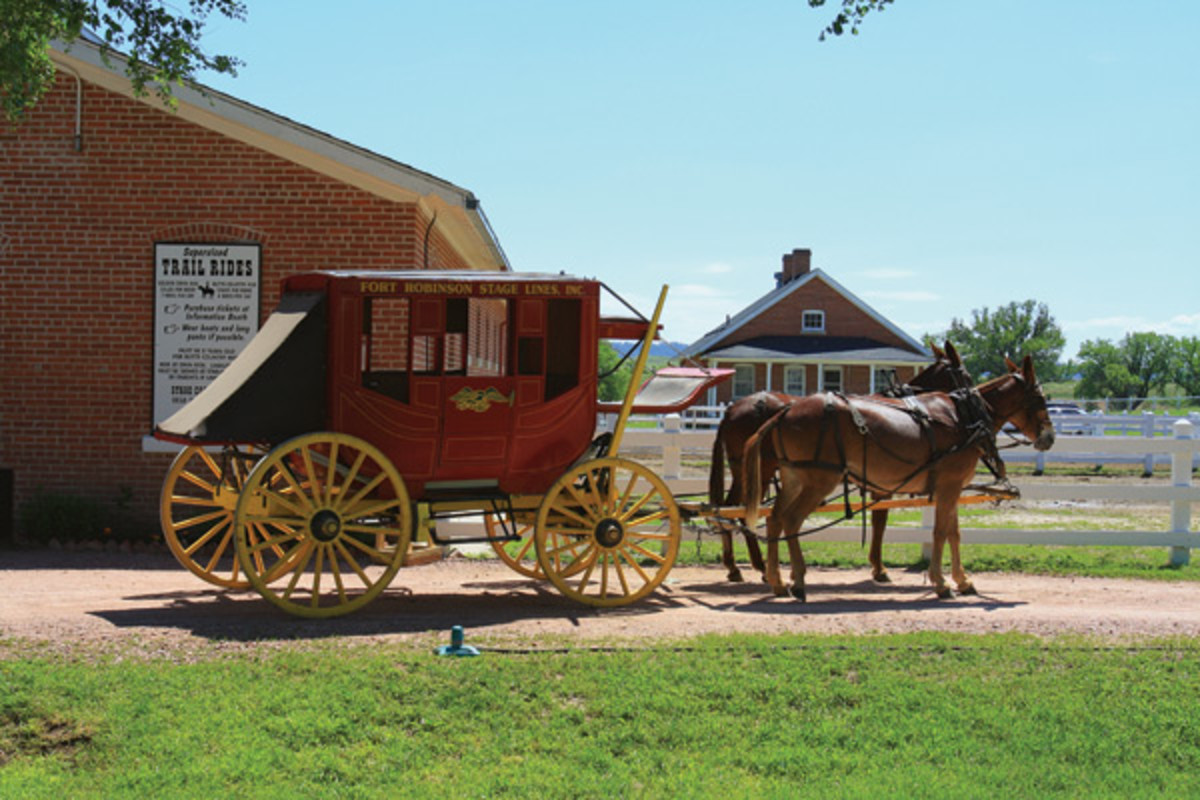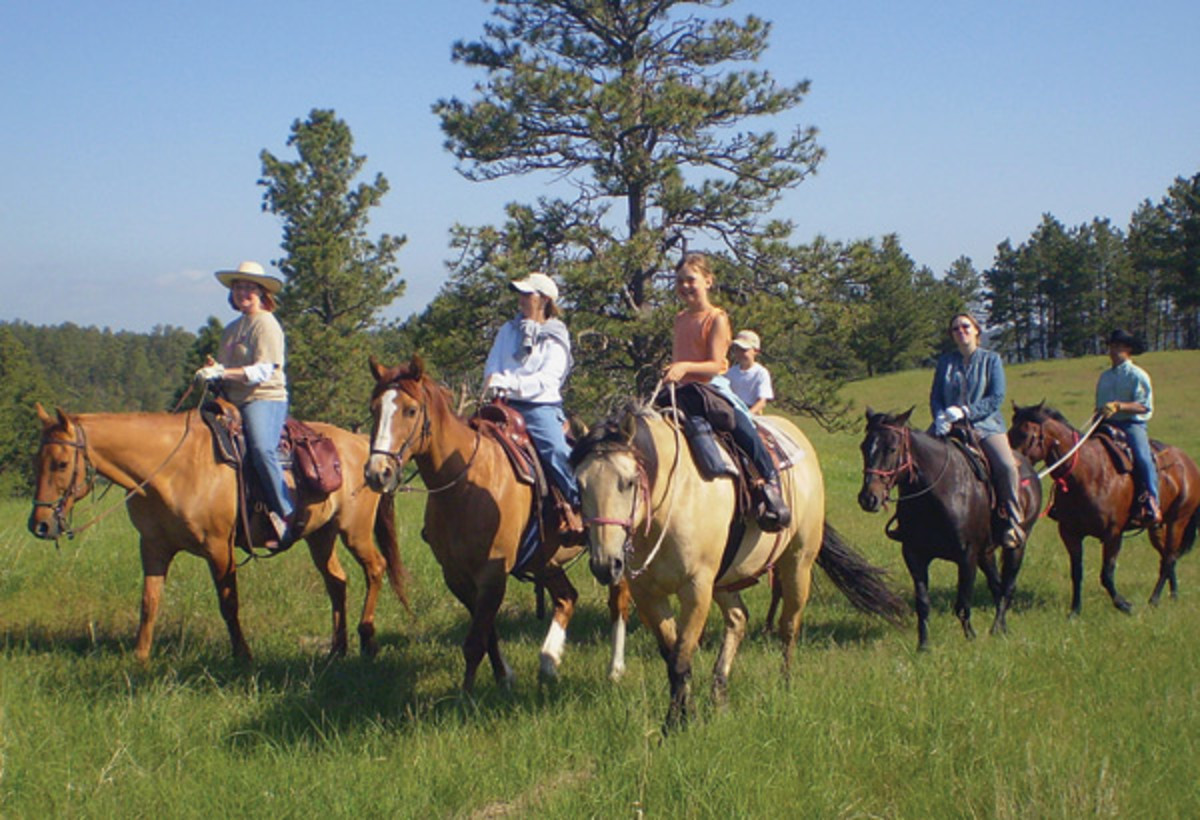
Interested in historic horseback riding adventures? Western Nebraska offers excellent opportunities amid a variety of terrain. There are miles of trails; scenery and wildlife abound. White cliffs and spring-fed streams are home to bighorn sheep, white-tail deer, mule deer, turkeys, songbirds, and golden eagles.
Nebraska is a great place to bring your horse and get immersed in a memorable riding experience.
Haven for Horses
Our Nebraska experience began at Fort Robinson, located near the town of Crawford. Historic Fort Robinson welcomes horses. Visitors may board horses, camp, and ride right out of the fort. Fort Robinson is Nebraska’s largest and most historic state park. It was established in 1874, in part, to protect the Red Cloud Agency. Famed Sioux warrior, Chief Crazy Horse, was killed here in 1877.
Following the Indian Wars, Fort Robinson became the nation’s largest remount depot. As many as 30,000 horses and mules were boarded and processed there. A breeding program was established to improve horse stock for the cavalry. From 1935 to 1939, the United States Olympic Equestrian Team trained at the fort. Later, prisoners of war were kept here during World War II.
Many historic buildings still remain. A sign over the entrance to a former barracks, which is now the visitor center, reads, “Thru these portals pass the Army’s best horsemen.” This refers to the many cavalry officers and troopers stationed here during its operation as a military post.
Fort Robinson can currently stall 150 horses. You may keep horses in the 1909 brick cavalry stables or in the mare-barn complex. Both facilities have space for nearby camping. There are also three other campgrounds in the park where you can stay with your horse.
If you prefer not to camp, you may rent cabins, officer quarters, or barracks, all dating from the 1870s and 1880s.
Fort Robinson is a stately, manicured, calendar photo. It’s set against a background of crystal-blue skies and imposing buttes that jut out of the northern grassy plain. Just south of the fort, a meandering Soldier Creek wanders aimlessly through a valley covered with cottonwoods.

Buttes & Bluffs
It’s easy to forget present day and imagine the cavalry racing over the hill. Our riding was much calmer! A good place to begin riding is the Soldier Creek trail; access this trail by going behind the cavalry barracks and heading straight south.
This trail meanders along the creek, through cottonwoods, to Carter P. Johnson Lake. One downside to this trail is a number of gates you must open and close along the way. However, on a hot day, this is an easy, shady ride. Most folks head north out of the fort, across a grassy plain, to the beautifully sculptured buttes. Trails wind around the buttes. There, you can make loops through rock formations with such names as Chaffee Butte, Red Cloud Butte, and Coffin Butte.
You can even ride to the top of some of these rock formations, for tremendous views of the surrounding country. Just west of the fort is the Mexican Canyon trailhead. Be careful at the trailhead: There’s a small turnaround, possibly not good for large trailers. To avoid the trailer issue, ride from the fort. You can ride west on a trail that roller-coasts its way up and through bluffs.
You can also ride east from the trailhead. Ride downhill, cross the creek, and follow a trail that winds through open grasses at the base of dramatic buttes. Watch for mountain sheep that may be watching you!
If you’re looking for a genuine Western experience, ride through the buttes into the horse-friendly town of Crawford, tie your horse to a hitching rail, then get a bite to eat and something cold to wash down the trail dust. Ride back to the fort on a trail that sort of follows the highway completing a loop. It’s a lifetime memory.
Ray Evans, owner of the Circle E Campground in Tennessee, and his friend, Gerall Sanders, did the Crawford loop ride. They rode off into the sunset and came back under a starry Nebraska sky.
[PAGEBREAK]

Into the Wilderness
We trailered a few miles west of the fort to the Soldier Creek trailhead. Directly adjacent to the trailhead is the Soldier Creek Wilderness Area. This special region was designated wilderness in 1989 because of its unique, pristine qualities. Trailhead facilities include primitive campsites, water, toilets, and spacious (although weed-filled) corrals. This is a good place to camp, ride in the wilderness, and enjoy sunsets across the valley.
On this trip, we were riding our new, young horses. For them, everything was fresh and exciting. For us, a tad stressful! As it turned out, the wet-blanket treatment — that is, many miles on the trail — was beneficial for all of us. My new horse is a Missouri Fox Trotter gelding named Cowboy. Charlene’s horse is a Fox Trotter gelding named Nate. At the time, they were both not quite 4 years old. Despite their youth, they did an awesome job crossing streams, and remained calm when surprised by deer, birds, ATVs, bicycles, and cattle.
Soldier Creek Wilderness provides plenty of terrain for cross-country riding, as well as trails and loops. One good loop is the Boots and Saddle Trail, which can be combined with the Trooper Trail for a larger loop. Three forks of Soldier Creek come together near the trailhead. The Trooper Trail switchbacks up a steep ridge, then follows the divide above the Middle Fork of Soldier Creek. For several miles, it follows grassy parks and passes by old fire-killed pines.
Near two windmills, it’ll turn south and drop into the South Fork of Soldier Creek. Follow the south fork through a verdant, cottonwood tree-filled valley to the trailhead. The Boots and Saddle Trail leaves from the north end of the trailhead and follows the North Fork of Soldier Creek. It slowly climbs to the northeast corner of the wilderness unit. From here, the trail turns west and crosses the North Fork of Soldier
Creek at the site of the old Officer’s Club.
There’s a sign denoting this club, but only foundations remain today. Still, this is a great spot to pause and ponder days gone by. It was here that officers would come by horse and wagon from Fort Robinson to enjoy festive gala parties. This was also one of the training locations for the U.S. Olympic Equestrian team during the 1930s.
From the Officer’s Club, you can ride west to the Trooper Trail or take a shortcut back to the trailhead by following the North Fork. If you take the shortcut, you’ll see the faint, grass-covered ruts of an old military road. Depending on your rank and station, you’d use this road to go to the club or a wood-gathering expedition.

Ranch Life
In western Nebraska, there are a number of ranches that provide guests with entertaining riding vacations and authentic ranch experiences. Here are two that we recommend.
• Ponderosa Ranch. Not far from the town of Crawford, nestled in scenic Pine Ridge, is the Ponderosa Ranch. Owners and hosts Jeff and Kim Lund operate the 3,300-acre working cattle ranch. The ranch has rugged diverse beauty: spectacular views in every direction, open rolling grass meadows, steep hills, ridges studded with Ponderosa pine trees, and canyons lined with green ash and cottonwoods.
Ranch-broke Quarter Horses are available or you may bring your own horse. You’ll enjoy comfortable cabins and delicious meals surrounded by sage-scented air and wide-open spaces.
Guests are required to have some previous riding experience, as they’ll participate in working-ranch activities. In May, guests round up the herd to brand and vaccinate the calves. In June, the bulls are driven out to pasture and brought back at the end of August. In fall, the entire herd is rounded up so that calves can be weaned and sold.
You may participate in as little or as many activities as you wish. Other tasks include checking water, filling salt and mineral bins, gathering strays, fixing fence, and doctoring sick cattle.
“Ponderosa Ranch ranch has rugged, diverse beauty,” note the Krones. “Ranch-broke Quarter Horses are available, or you may bring your own horse.”
• Flying Bee Ranch. This ranch is located about 100 miles south of Crawford, near the town of Bayard. We visited with the ranch’s gracious owners, Conrad and Louise Kinnaman. There’s a great deal to do and see at the Flying Bee. Tom Seay, host of Best of America by Horseback on RFD-TV, enjoyed this ranch so much that he visited here twice! We could certainly understand why guests would want to return again and again.
[PAGEBREAK]
The ranch is situated in a beautiful grassy area surrounded by jagged-edged bluffs. Away in the distance, piercing the sky, stands chimney rock. Very majestic.
Not far away is the Oregon Trail and historic Scott’s Bluff National Monument. History also abounds on the ranch. Together, Conrad and Louise have discovered teepee rings, arrowheads, and other historical artifacts.Guests are encouraged to explore the many trails on the 4,000-acre ranch. And there are a variety of trails: gentle rolling grassland trails; trails along rugged pine-dotted bluffs; and trails into canyons.
You may bring your own horse and ride terrain dotted with fragrant evergreens, unusual rock formations, and panoramic views that stretch for miles. The Flying Bee provides visitors with detailed trail maps. We asked the Kinnamans about their favorite trails. Louise said she enjoyed Trail #1, with its 360 degree panoramic views. Conrad had no favorites, saying, “They’re all fantastic!”
Lodging facilities include a secluded cabin for six with full bath and kitchen, two B&B guest rooms, and a campground with electrical and water hookups. Stalls are available for your horses.

Happy Trails
It was time for us to leave western Nebraska and head to our home in the Northern Rockies. As we traveled west, we discussed, once again, the incredible richness horses have brought to our lives. Exploring on horseback makes a person slow down, and savor sights, smells, and sounds. It’s a way of gearing down in a world that moves too fast.
So — come on out to Nebraska! Bring your horse. Explore the past, and enjoy the present.
Kent and Charlene Krone combine their interest in photojournalism with a passion for horses. They’ve sold photographs to magazines, books, calendars, postcards, and video producers for more than 20 years. (For a sampling, visit www.superstock.com, and type “Kent and Charlene Krone” in the search box.) They enjoy sharing their horseback adventures in the United States and Western Canada. Reach them at kckrone@suddenlink.net.






